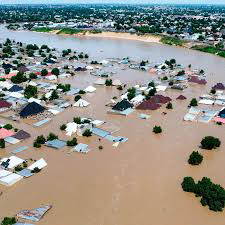Torrential Rains Loom: FG Issues Flood Alert in 19 States as National Death Toll Rises to 191
The Federal Government has raised an alarm over the impending torrential rainfall expected to affect 19 states between August 5 and 9, potentially triggering severe flooding in over 70 locations. The alert, issued by the National Flood Early Warning Systems Centre under the Ministry of Environment, calls for urgent action from residents in vulnerable areas.
According to the Centre’s update on Tuesday, the anticipated downpour may trigger flash floods, displacing communities and endangering lives if precautions are not taken.
This new warning follows recent flood incidents across several states, including Ogun and Gombe, where heavy rains have already caused widespread destruction. Other affected states include Lagos, Plateau, Delta, and Anambra, which have all recorded significant damage in the last few days.
States on Red Alert
High-risk areas span a broad swath of the country, including parts of Akwa Ibom, Ebonyi, Bauchi, Benue, Nasarawa, Kaduna, Katsina, Kebbi, Kano, Niger, Plateau, Taraba, Jigawa, Sokoto, Yobe, Zamfara, Borno, Cross River, and Gombe.
Nigeria’s flood situation has taken a grim turn in 2025, with the National Emergency Management Agency (NEMA) reporting that 191 lives have been lost so far. The disaster has impacted over 134,000 people across 47 Local Government Areas in 20 states, with 94 persons still unaccounted for.
Ogun, Gombe, Lagos Bear the Brunt
In Ogun State, floodwaters engulfed major areas of Redemption City along the Lagos-Ibadan Expressway, trapping worshippers and motorists. Members of the Redeemed Christian Church of God (RCCG) deployed buses to rescue stranded residents, while makeshift canoes were used in Mowe and OPIC for navigation.
In Gombe State, at least four lives were lost due to flood-induced windstorms. A total of 278 households were affected, with incidents recorded in Gombe, Dukku, and Kwami LGAs.
READ ALSO: BREAKING: Nigeria’s First Female Daily Editor, Dr. Doyin Abiola, Passes On
Lagos State also experienced heavy flooding in areas such as Lekki, Ikorodu, Agege, Surulere, Ajegunle, and Ijede. Social media was flooded with distressing footage, including a barefoot woman weeping and lamenting in Yoruba: “Everything has been lost.”
Dire Statistics and Comparisons
The latest NEMA figures are staggering:
-
48,056 displaced persons
-
239 injured
-
9,499 houses damaged
-
9,450 farmlands affected
The vulnerable groups include over 60,000 children, 41,500 women, nearly 6,000 elderly persons, and 1,874 people living with disabilities.
In comparison, 2024 was even more devastating, with floods affecting 5.2 million Nigerians, leading to 1,237 deaths and displacing over 1.2 million people in 35 states.
Widespread State-Level Impact
-
Delta State: Sapele and Oko communities are underwater; six IDP camps have been activated.
-
Kebbi State: Torrential rains in Diggi town have displaced hundreds.
-
Bauchi State: Over a dozen homes destroyed in Dass LGA.
-
Plateau State: Shimankar District witnessed extensive damage to schools and homes.
-
Imo State: Oguta alone has 27 submerged villages; flash floods have reached Owerri West.
-
Rivers State: Flash flooding disrupted life in Obio/Akpor and Port Harcourt LGAs, prompting calls for emergency measures.
-
Sokoto State: Joint assessments are ongoing in Shagari, Yabo, and Tureta LGAs following mass displacement.
Federal Funding and State Response
To mitigate the worsening crisis, the National Economic Council approved the following:
-
₦3 billion to each of Nigeria’s 36 states and the FCT
-
₦1.5 billion each to Federal Ministries of Environment, Water Resources, Budget and Planning
-
₦10 billion earmarked for NEMA’s disaster response operations
Some state governments, including Bayelsa, Nasarawa, Edo, Katsina, Benue, and Kaduna, have begun public awareness campaigns, set up emergency shelters, and activated rapid response teams to prepare for further flooding.
Experts Call for Structural Reforms
Environmentalists and disaster risk experts argue that recurring flood disasters are a symptom of larger governance issues—poor drainage systems, unchecked urban sprawl, and lack of enforcement of environmental laws.
Dr. Fyneface Dumnamene, a frontline environmental advocate, urged immediate structural reforms:
“We may not be able to stop the rains, but we can certainly reduce the pain.”
With predictions of heavier rainfall in the weeks ahead, both federal and state authorities are under pressure to move from reactionary relief to proactive mitigation—before more lives and livelihoods are lost.




